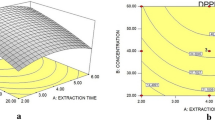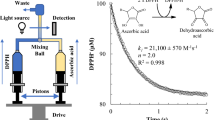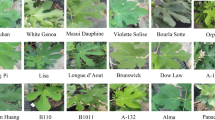Abstract
Aerobic metabolism requires a complex antioxidative system to balance reactive oxygen species (ROS). When in excess, ROS disrupt cellular activities and molecular structures. Owing to the variety of ROS, there are different antioxidative activities that require various tests for their detection. The so-called 'total antioxidative capacity' inhibition assay presented in this paper can be used to quantify the overall activity of low-molecular-weight antioxidants (AOs) in biological samples. The assay is based on enhanced horseradish peroxidase–catalyzed luminol chemiluminescence. It can be fine-tuned so that the biological samples meet the requirements of the light detector. A detailed protocol describing all relevant parameters is provided. The procedure is quick, inexpensive and reproducible. The assay can be used with diverse biological materials such as plant extracts and blood plasma. Hence, it is applicable to fields as diverse as crop breeding, medical diagnostics or food sciences. The time needed for the assay depends on the number of samples and their AO content. The protocol takes one working day to complete when five samples with five replicates are measured sequentially.
This is a preview of subscription content, access via your institution
Access options
Subscribe to this journal
Receive 12 print issues and online access
$259.00 per year
only $21.58 per issue
Buy this article
- Purchase on Springer Link
- Instant access to full article PDF
Prices may be subject to local taxes which are calculated during checkout






Similar content being viewed by others
References
Mittler, R. Oxidative stress, antioxidants and stress tolerance. Trends Plant Sci. 7, 405–410 (2002).
Shao, H.-B., Chu, L.-Y., Lu, Z.-H. & Kang, C.-M. Primary antioxidant free radical scavenging and redox signaling pathways in higher plant cells. Int. J. Biol. Sci. 4, 8–14 (2008).
Chanvitayapongs, S., Draczynska-Lusiak, B. & Sun, A.Y. Amelioration of oxidative stress by antioxidants and resveratrol in PC12 cells. Neuroreport 8, 1499–1502 (1997).
Leutner, S., Eckert, A. & Müller, W.E. ROS generation, lipid peroxidation and antioxidant enzyme activities in the aging brain. J. Neural Transm. 108, 955–967 (2001).
Gogorcena, Y., Iturbe-Ormaetxe, I., Escuredo, P.R. & Becana, M. Antioxidant defenses against activated oxygen in pea nodules subjected to water stress. Plant Physiol. 108, 753–759 (1995).
Gomez, J.M., Jimenez, A., Olmos, E. & Sevilla, F. Location and effects of long-term NaCl stress on superoxide dismutase and ascorbate peroxidase isoenzymes of pea (Pisum sativum cv. Puget) chloroplasts. J. Exp. Bot. 55, 119–130 (2004).
Hernandez, J.A. et al. Antioxidant systems and O2•−/H2O2 production in the apoplast of Pea leaves. Its relation with salt-induced necrotic lesions in minor veins. Plant Physiol. 127, 817–831 (2001).
Sreenivasulu, N., Grimm, B., Wobus, U. & Weschke, W. Differential response of antioxidant compounds to salinity stress in salt-tolerant and salt-sensitive seedlings of foxtail millet (Setaria italica). Physiol. Plant. 109, 435–442 (2000).
Apak, R., Guclu, K., Ozyurek, M. & Karademir, S.E. Novel total antioxidant capacity index for dietary polyphenols and vitamins C and E, using their cupric ion reducing capability in the presence of neocuproine: CUPRAC method. J. Agric. Food Chem. 52, 7970–7981 (2004).
Hon-Wing, L., Vang, M.J. & Mavis, R.D. The cooperative interaction between vitamin E and vitamin C in suppression of peroxidation of membrane phospholipids. Biochim. Biophys. Acta 664, 266–272 (1981).
Yeum, K.-J., Russell, R.M., Krinsky, N.I. & Aldini, G. Biomarkers of antioxidant capacity in the hydrophilic and lipophilic compartments of human plasma. Arch. Biochem. Biophys. 430, 97–103 (2004).
Saleh, L. & Plieth, C. Fingerprinting antioxidative activities in plants. Plant Methods 5, 2 (2009).
Saleh, L. & Plieth, C. A coelenterazine-based luminescence assay to quantify high-molecular-weight superoxide anion scavenger activities. Nat. Protoc., advance online publication, 16 September 2010, doi:10.1038/nprot.2010.121.
Gillespie, K.M. & Ainsworth, E.A. Measurement of reduced, oxidized and total ascorbate content in plants. Nat. Protoc. 2, 871–874 (2007).
Knörzer, O.C., Burner, J. & Boger, P. Alterations in the antioxidative system of suspension-cultured soybean cells (Glycine max) induced by oxidative stress. Physiol. Plant. 97, 388–396 (1996).
Zhang, J. & Kirkham, M. Antioxidant responses to drought in sunflower and sorghum seedlings. New Phytol. 132, 361–373 (1996).
Daood, H.G. et al. Antioxidant vitamin content of spice red pepper (paprika) as affected by technological and varietal factors. Food Chem. 55, 365–372 (1996).
Falk, J., Andersen, G., Kernebeck, B. & Krupinska, K. Constitutive overexpression of barley 4-hydroxyphenylpyruvate dioxygenase in tobacco results in elevation of the vitamin E content in seeds but not in leaves. FEBS Lett. 540, 35–40 (2003).
Azevedo, A.M. et al. Horseradish peroxidase: a valuable tool in biotechnology. Biotechnol. Annu. Rev. 5, 199–247 (2003).
Díaz, A.N., Sánchez, F.G. & Garcia, J.A.G. Phenol derivatives as enhancers and inhibitors of luminol-H2O2-horseradish peroxidase chemiluminescence. J. Biolumin. Chemilumin. 13, 75–84 (1998).
Nakamura, M. & Nakamura, S. One- and two-electron oxidations of luminol by peroxidase systems. Free Radic. Biol. Med. 24, 537–544 (1998).
Nicell, J.A. & Wright, H. A model of peroxidase activity with inhibition by hydrogen peroxide. Enzyme Microb. Technol. 21, 302–310 (1997).
Veitch, N.C. Horseradish peroxidase: a modern view of a classic enzyme. Phytochemistry 65, 249–259 (2004).
Gillespie, K.M., Chae, J.M. & Ainsworth, E.A. Rapid measurement of total antioxidant capacity in plants. Nat. Protoc. 2, 867–870 (2007).
Girotti, S. et al. Plasma antioxidant capacity determination: comparative evaluation of chemiluminescent and spectrophotometric assays. Talanta 56, 407–414 (2002).
Pellegrini, N. et al. Total antioxidant capacity of plant foods, beverages and oils consumed in Italy assessed by three different in vitro assays. J. Nutr. 133, 2812–2819 (2003).
Speisky, H. et al. Antioxidant screening of medicinal herbal teas. Phytother. Res. 20, 462–467 (2006).
Harper, L., Nuttall, S.L., Martin, U. & Savage, C.O.S. Adjuvant treatment of patients with antineutrophil cytoplasmic antibody-associated vasculitis with vitamins E and C reduces superoxide production by neutrophils. Rheumatology 41, 274–278 (2002).
Girotti, S. et al. Chemiluminescent determination of antioxidant capacity of beverages. Ital. J. Food Sci. 2, 113–122 (2002).
Girotti, S. et al. Chemiluminescent determination of total antioxidant capacity during winemaking. Luminescence 21, 233–238 (2006).
Jaffar, N.-Z. et al. The use of Pholasin as a probe for the determination of plasma total antioxidant capacity. Clin. Biochem. 39, 55–61 (2006).
Kampa, M. et al. A new automated method for the determination of the Total Antioxidant Capacity (TAC) of human plasma, based on the crocin bleaching assay. BMC Clin. Pathol. 2, 3 (2002).
Kim, D.-O., Lee, K.W., Lee, H.J. & Lee, C.Y. Vitamin C equivalent antioxidant capacity (VCEAC) of phenolic phytochemicals. J. Agric. Food Chem. 50, 3713–3717 (2002).
Li, L. et al. A fluorometric assay to determine antioxidant activity of both hydrophilic and lipophilic components in plant foods. J. Nutr. Biochem. 20, 219–226 (2009).
Ou, B., Hampsch-Woodill, M. & Prior, R.L. Development and validation of an improved oxygen radical absorbance capacity assay using fluorescein as the fluorescent probe. J. Agric. Food Chem. 49, 4619–4626 (2001).
Ou, B. et al. Analysis of antioxidant activities of common vegetables employing oxygen radical absorbance capacity (ORAC) and ferric reducing antioxidant power (FRAP) assays: a comparative study. J. Agric. Food Chem. 50, 3122–3128 (2002).
Serpen, A., Gökmen, V., Pellegrini, N. & Fogliano, V. Direct measurement of the total antioxidant capacity of cereal products. J. Cereal Sci. 48, 816–820 (2008).
Wayner, D.D.M., Burton, G.W., Ingold, K.U. & Locke, S. Quantitative measurement of the total, peroxyl radical-trapping antioxidant capability of human blood plasma by controlled peroxidation: the important contribution made by plasma proteins. FEBS Lett. 187, 33–37 (1985).
Schlesier, K., Harwat, M., Böhm, V. & Bitsch, R. Assessment of antioxidant activity by using different in vitro methods. Free Radic. Res. 36, 177–187 (2002).
Cao, G. & Prior, R.L. Comparison of different analytical methods for assessing total antioxidant capacity of human serum. Clin. Chem. 44, 1309–1315 (1998).
Girotti, S., Bolelli, L., Budini, R. & Arfelli, G. Comparison of analytical methods in determining total antioxidant capacity in red wine. Anal. Lett. 35, 747–758 (2002).
Janaszewska, A. & Bartosz, G. Assay of total antioxidant capacity: comparison of four methods as applied to human blood plasma. Scand. J. Clin. Lab. Invest. 62, 231–236 (2002).
Said, T.M. et al. Enhanced chemiluminescence assay versus colorimetric assay for measurement of the total antioxidant capacity of human seminal plasma. J. Androl. 24, 676–680 (2003).
Sanchez-Moreno, C. Review: methods used to evaluate the free radical scavenging activity in foods and biological systems. Food Sci. Technol. Int. 8, 121–137 (2002).
Wang, C.C. et al. Trolox-equivalent antioxidant capacity assay versus oxygen radical absorbance capacity assay in plasma. Clin. Chem. 50, 952–954 (2004).
Rice-Evans, C. Measurement of total antioxidant activity as a marker of antioxidant status in vivo: procedures and limitations. Free Radic. Res. 33 Suppl.: S59–S66 (1999).
Vassalle, C. et al. In vivo total antioxidant capacity: comparison of two different analytical methods. Clin. Chem. Lab. Med. 42, 84–89 (2004).
Whitehead, T.P., Thorpe, G.H.G. & Maxwell, S.R.J. Enhanced chemiluminescent assay for antioxidant capacity in biological fluids. Anal. Chim. Acta 266, 265–277 (1992).
Sies, H. Total antioxidant capacity: appraisal of a concept. J. Nutr. 137, 1493–1495 (2007).
Girotti, S. et al. Automated and manual luminescent assay of antioxidant capacity: analytical features by comparison. Talanta 64, 665–670 (2004).
Ghiselli, A., Serafini, M., Natella, F. & Scaccini, C. Total antioxidant capacity as a tool to assess redox status: critical view and experimental data. Free Radic. Biol. Med. 29, 1106–1114 (2000).
Nazari, K. et al. Stabilizing and suicide-peroxide protecting effect of Ni2+ on horseradish peroxidase. J. Iranian Chem. Soc. 2, 232–237 (2005).
Burlingame, J. et al. Total antioxidant capacity and reactive oxygen species in amniotic fluid. Obstet. Gynecol. 101, 756–761 (2003).
Puntarulo, S. & Cederbaum, A.I. Chemiluminescence from acetaldehyde oxidation by xanthine oxidase involves generation of and interactions with hydroxyl radicals. Alcohol Clin. Exp. Res. 13, 84–90 (1989).
Wippich, N. et al. Comparison between xanthine oxidases from buttermilk and microorganisms regarding their ability to generate reactive oxygen species. Int. J. Mol. Med. 7, 211–216 (2001).
Ziobro, A. & Bartosz, G. A comparison of the total antioxidant capacity of some human body fluids. Cell Mol. Biol. Lett. 8, 415–419 (2003).
Evelson, P. et al. Evaluation of total reactive antioxidant potential (TRAP) of tissue homogenates and their cytosols. Arch. Biochem. Biophys. 388, 261–266 (2001).
Chuang, C.-C. et al. Serum total antioxidant capacity reflects severity of illness in patients with severe sepsis. Crit. Care. 10, 1 (2006).
Lewinska, A., Wnuk, M., Slota, E. & Bartosz, G. Total anti-oxidant capacity of cell culture media. Clin. Exp. Pharmacol. Physiol. 34, 781–786 (2007).
Acknowledgements
We thank L. Shaw (Kiel) for critically reading the paper. We also thank S. Vollbehr, G. Weppner and S. Anderson for technical assistance; J. Scheller (Institute for Biochemistry, University of Kiel) for providing HepG2 cells; and A. Scheidig (Structural Biology Group, Kiel) and U.-P. Hansen (Biophysics Group, Kiel) for their generous support. We gratefully acknowledge the financial support of the Deutsche Forschungsgemeinschaft (Grant no. PL253/5), as well as access to the core facilities of the Zentrum für Biochemie und Molekularbiologie, Christian-Albrechts-Universität, Kiel.
Author information
Authors and Affiliations
Contributions
L.S. carried out the experiments reported in the main paper, performed data processing and participated in amending the draft. C.P. conceived of the protocol, carried out the experiments shown in the supplementary information and wrote the paper. Both authors approved the final version.
Corresponding author
Ethics declarations
Competing interests
The authors declare no competing financial interests.
Supplementary information
Supplementary Fig. 1
Decay of the antioxidative capacity of pure antioxidants (PDF 15 kb)
Rights and permissions
About this article
Cite this article
Saleh, L., Plieth, C. Total low-molecular-weight antioxidants as a summary parameter, quantified in biological samples by a chemiluminescence inhibition assay. Nat Protoc 5, 1627–1634 (2010). https://doi.org/10.1038/nprot.2010.120
Published:
Issue Date:
DOI: https://doi.org/10.1038/nprot.2010.120
This article is cited by
-
Jasmonic Acid Improves Growth Performance of Soybean Under Nickel Toxicity By Regulating Nickel Uptake, Redox Balance, and Oxidative Stress Metabolism
Journal of Plant Growth Regulation (2018)
-
Multiwell cartridge with integrated array of amorphous silicon photosensors for chemiluminescence detection: development, characterization and comparison with cooled-CCD luminograph
Analytical and Bioanalytical Chemistry (2014)
-
A coelenterazine-based luminescence assay to quantify high-molecular-weight superoxide anion scavenger activities
Nature Protocols (2010)
Comments
By submitting a comment you agree to abide by our Terms and Community Guidelines. If you find something abusive or that does not comply with our terms or guidelines please flag it as inappropriate.



